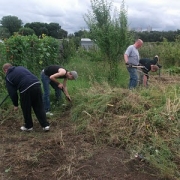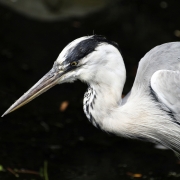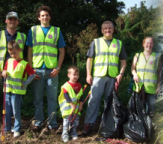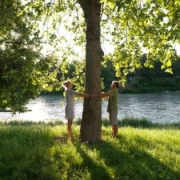Eco-Revolution
By Eowyn OR
To a greater or lesser degree, most Odinists are aware that the environment is vital for the wellbeing of all our folk across the generations. However, it is also glaringly obvious that our own reverence for Mother Jorth is not matched by wider culture, which, on the contrary, abuses her for profit above all else because the paradigms on which its actions are moulded are honed by the anathema of an alien creed. Yet, Odinists do not seek to totally separate themselves out into illusory self-contained communes in a vain attempt to escape the effects of the modern world but instead, valiantly seek to work within it and in doing so, to spread the holy flame of our folk. Nevertheless, this noble double-edged sword means that much of life becomes a balancing act of the need to work within the parameters set by this alien basis- just so that we can survive within wider society- set against our work for the New Awakening, whose value system often opposes them. Obviously, survival will take precedence for much of the time; but this also means our attempts to maintain the surge towards the New Awakening can be compromised by these concerns and without perseverance, risk being completely swamped out of all recognition. Ultimately, focus is lost and when we later try to recover the thread from the forest of daily life, it can be difficult to see how our principles can be diligently applied in this context. Further, matters are not helped by the relentless measures being taken to suppress our folkways and over time, this has meant that picking out the threads of ancient wisdom from the tapestry of illusory dross that we have been drowned in since birth can often be a daunting undertaking through highways and byways with many traps along the way. Our folk have suffered two millennia of such suppression by the alien creed and it is from such a long winter of starvation against the odds that we have to regroup ourselves.
One way in which we can help ourselves is to look to other folk groups who in many ways, have been impacted less by the Judaeo-Christian influence. It is possible to use them as a ‘mirror’ for reawakening ourselves to those aspects of our folkways that have been lost in the mists of time and thus, we can begin to complete the jigsaw of knowledge. This most certainly does not mean we seek to emulate their traditions: that would be undesirable for all parties concerned. Each folk group has their own way of communing with deity and expressing their understandings through culture and this is natural. But behind those unique expressions, natural principles that are inherent within the whole of humanity can be found and in some folk groups, certain expressions of these principles are better preserved than in others, dependent upon their political history and socio-cultural milieu. By scraping away the cultural veneer, we can expose the essence and use the illumination from that to catalyse and reawaken our own inner radiance, which will then be expressed in our folk’s unique way. And so we can advance certain aspects of our ways more truly than if we were just to flounder in the swamp of inculcated ignorance and patchy knowledge without such aid.
The Coconut Revolution’ (1999), is the story of an amazing example of ecological revolution in the modern world. It recounts the recent history of Bougainville, an island in the Pacific Ocean a few hundred miles from Australia and the people’s fight to maintain their environment and to gain independence from Papua New Guinea and Australia. It is described as being the longest and bloodiest conflict since World War 2, where the islanders took on Papua New Guinea, Australia and the biggest open cast mining company in the world, lost one tenth of their population and began the world’s first true eco-revolution. I found it a fascinating study from which I feel we can learn much, whilst seeing reflections of our own awareness operating very successfully in a different environment; thus, it actively demonstrates their timelessness and integrity. For increased clarity, I shall present it as sections.
The Story
Bougainville’s history has been one of geographical, ethnic and cultural ‘pass the parcel’ ever since the French explorer Louis De Bougainville applied his name to the map. The last hundred years has seen this part of the Solomon Islands constantly moved between various imperial powers. It belonged to Britain but was then grabbed by Australia and Japan during World War 2; later, it became part of Papua New Guinea, who declared independence in 1975. Two weeks earlier, Bougainvillle had done the same- except for some reason, nobody listened.
During the 1960’s, Bougainville Copper Ltd (BCL), a subsidiary of the mining giant Rio Tinto Zinc, began massive open cast mining on the island, covering 7 square kilometres and to a depth of 500 metres. In the process, hills were removed and huge areas of the island’s fertile heartland made barren. 1 billion tonnes of pollution spilled out and flowed down the Java River. Containing mercury, arsenic, lead and copper, wildlife was killed and entire forests were transformed into moonscapes. The river system has been destroyed, the water is undrinkable and nobody can swim in it- damage which will probably persist for at least 200 years.
In the beginning, the islanders were ignorant of the intended size of the mine and its consequences; however, as this- in addition to the 3 billion dollars profit it was making whilst only returning 1/100th of that to the people (i.e. the rightful landowners)- became apparent, they protested; but the land was then taken by force.
In 1988, events came to a head when the Young Land Owner’s Association- headed by Francis Ona- demanded the mine’s closure plus 10 billion dollars in damages; apparently, BCL laughed them off as this was more than the mine was worth. So Francis hurriedly left the meeting, broke into the mining depot, stole 50 kilos of high explosives and, with the aid of his friends, began measures to close down the mine themselves through some strategic sabotage: BCL had created their most expensive enemy and birthed the Bougainville Revolutionary Army (BRA). Papua New Guinea panicked that they would lose half their export earnings and so they sent in the riot squad to burn down houses, beat and kill several people in the hope of overpowering the BRA; instead, the guerrilla force’s numbers swelled in response and so the army sent in the Papua New Guinea defence force (PNG). Rio Tinto Zinc abandoned the mine and the war between Papua New Guinea and Bougainville had started. Francis then realised they were also fighting Australia: due to ex-colonial interests, it was already training an arm of the PNG and conveniently suspended a foreign crimes act to allow pilots to fly the helicopters it had suddenly mustered; these were then turned into gun-ships against an unarmed population. Thus the Bougainvillians were forced into the start of a long line of innovations.
In 1990, the PNG and Australians were losing control of the majority of the island and so began a 7 year siege of it in the hope of turning the population against the BRA: the opposite happened as the people joined the BRA’s efforts and necessity became the mother of further inventions: in the face of such adversity, the people became self-sufficient.
Since their plans had been foiled, Papua New Guinea government hired mercenaries to complete the job. Amazingly, the PNG came to the BRA’s aid having seen the government’s move as openly humiliating against a backdrop of under-funding. The mercenaries were simply thrown out! In mid 1997- and after hearing about this debacle- the international community began peace talks with Bougainville. Since then, the blockade has been lifted but up to the date of the programme, Papua New Guinea was still diligently avoiding the issue of a referendum on independence.
The Innovations
The Bougainville story is a classic and unique example of eco-revolution in the modern age where a folk group doesn’t merely just survive the harsh effects of a blockade, but actually thrives from it demonstrating in no uncertain manner that necessity is indeed ‘the mother of invention.’ Here follows a synopsis of the innovations resulting directly from the war.
Weapons: At the start of the war, the BRA had no suitable weapons. They went on to invent a sling-shot weapon using a self-loading rifle with arrows and with that, they managed to gradually win 200-300 powerful weapons whilst also reclaiming material from machines left behind at the Panguna mine to make more guns. By cutting down the machines, joining parts together and labelling them with a serial number, they can rebuild the guns if a part is destroyed in the field. This also builds confidence amongst the force.
Food: When the blockade was enforced, every family had no alternative but to become self-sufficient. Thus they began to cultivate their own gardens using a ‘shifting cultivation’ type of gardening so as to integrate every food crop they could find. Fortunately, the soil on the island is mineral rich and so the people can grow a large variety of foodstuffs including: sweet potato, bananas, cassava, taros, sugar cane, paw paw, yams, onions, corns, tomatoes, peanuts and potatoes.
Bush-craft and Medicine: During the crisis, thousands were dying from preventable diseases such as malaria and tetanus and unsanitised childbirth. However, by making the land their ally, they have developed their own medicine; examples include:
-After the extraction of some asbestos in one man’s foot (inadvertently acquired in the mine), herbs are put into the hollow of a paw paw pipe and blown with steam into the wound to dry it.
-One herb can locate areas of reduced blood flow i.e. damage; if damage-free, it will slide along the skin, but where there is a lesion, it sticks like glue.
-A herbal contraceptive that doesn’t harm women.
-Herbal concoctions to cure malaria, leprosy, appendicitis and cancer (without the need for operations.
-Francis Ona sent someone home after treatment for AIDS; no doctor’s reports followed to state the person had been cured but Francis believes they were. He invites anyone with AIDs to try the cure!
-Bush stealth- including a herb whose vapours clear the nose enough to smell enemies on the road; booby traps of herbs laid which, presumably, release their aroma when trodden on such as herbs to make the enemy sick. One trap they apparently lay has herbs which cause the testicles to swell up and the penis to enlarge!
Recycling: The Bougainvillians find uses for everything and will bring things back over many miles from successful operations to re-use. Their ‘Mecca’ as they describe it is Panguna Mine itself, where they scavenge anything they can: furniture, switch boxes, metal parts, locks and keys from the doors, water pumps, barbed wire, balls and other toys for their children to play with. From this, they have also cobbled together their own ecological hydroelectric power supply. Amazingly, there are some 50-60 small hydroelectric units across the island providing 24/7 lighting of entire villages and they even have their own music studio!
The Coconut: Of course, as with any society, a power supply is essential to survival and the Bougainvillians have an abundant supply of coconuts from which they can be entirely self-sufficient. As with everything else, they waste virtually nothing. Thus, the milk- being rich in iron- can be drunk; by placing the skin next to the fire and then squeezing it when hot, they have a balm for sores; the burning husk deters mosquitoes- of which there are plenty! The flesh is milked for cooking greens in; leaves are used for baskets; soap is made from the oil; fuel is obtained for lamps. The people manufacture three grades of oil from coconuts- grades A, B and C: their guns are cleaned with grade A oil.
Seven years into the war with a blockade on all food and fuel supplies, they were- and presumably are- still driving the vehicles that had been progressively won from the war around the island because of their innovative use of the coconut. By scraping, squeezing, fermenting and then cooking it, they can produce I litre of first grade oil from approximately 15 dry coconuts. This oil is far less polluting than standard diesel and other petrochemical versions and gives twice the mileage per litre used. Nature has literally helped them towards the creation of an independent state through efficient use of a natural resource- the humble coconut. Without the intrusion of politics, they would indeed be independent and entirely self-sufficient.
The Principles
Throughout the documentary, particular principles upon which the BRA’s action rested were apparent and in some cases, actually stated. Some of the most notable included the following:Basic Ethos: The Bougainvillians demonstrated a fierce reverence for their island, which they named ‘Mecca Maui’ (sacred Island). Francis Ona states the three core values for which the BRA is fighting:
1/ Man and his culture 2/ Land and the environment 3/ Independence
Sense of Time, Place and Responsibility in Life-cycle: Ishmael, the ‘Bougainville Ninja’ sums this up by stating that they don’t want future generations to say:
“our forefathers didn’t give us a good future, they’ve spoilt things for us- thrown us away and we’ve ended up like this.”
In the very beginning, Francis Ona realised that every part of the island had prized minerals sought by the multinational companies and recognised that their quest would bring destructive change for the future generations by spoiling the environment. Thus he acted upon this accurately perceived threat to the community: his actions in the present would help weave the future for all. He demonstrates an innate understanding of the need to be self-responsible within the context of the folk community and wider out into the environment upon which they depend for survival.
Optimism and Perseverance: At both the individual and community levels, a sense of optimism and perseverance pervades all the people. Despite the destruction of the land, 8 years of isolation, up to 15,000 deaths and untold atrocities, they remain optimistic and refuse to wallow in self-pity or pessimism. Ishmael for example, was attacked by an onslaught of grenades of which the fourth blew up on his left arm. Yet he has worked to ensure he can adeptly handle two guns simultaneously and leads the core in their regular operations to flush out intruders. Indeed, the people actually value the imposition of a blockade because it has honed them into a stronger and more resourceful community: Francis Ona even thanks the PNG’s government for having helped them effect this change! Meanwhile, the songs they sing together in their self-made music studio reflect a sense of optimism and they weave folktales of the fight for independence, their own government, the environment and true happiness.
Developing Natural Talents: The entire revolution has been a development of the people’s natural talents within the framework of the basic ethos. Nobody has been trained to do anything to which they aren’t suited and where possible, individual creativity has apparently been fostered for the benefit of all. Further, a practical and positive attitude is demonstrated: all weapons are easily remade by the BRA’s soldiers. This fosters their self-confidence as both a part of the force and as an individual which, of course, maintains morale and can therefore only aid their group’s cause through such a clearly channelled and optimistic approach.
Recycling: This has already been discussed but its importance to the success of the revolution cannot be overstated. Recycling is a principle of nature and in recognising their place in nature and the deleterious effects of the mine upon their ‘mother’- the environment- the Bougainvillians have sought to use everything they can towards a positive end. Thus parts from the mine were made into components for the hydroelectric power supply; every part of the coconut is used; the serial number system ensures guns are remade easily instead of being disposed of and so forth. Of course, by growing their own food, recycling is bound to be an integral aspect to the self-sufficiency of the Bougainvillian families.
Spirituality: Whilst it is somewhat disheartening to see such a positively motivated folk group ensnared by Christianity, it is nevertheless apparent the Bougainvillians have harnessed their spirituality in a very practical way. The impression is that the basic principles upon which they mould their action shape the expression of much of their spirituality. So for example, Ishmael embraces the guidance he receives via visions whilst out in the bush and states these have helped the BRA in tactics to ensnare the enemy. Meanwhile, at one point, the programme shows them saying prayers together and then immediately obeying instructions to clean up their guns- an expression perhaps of the definitely practical base to their spirituality!
In many ways, this mirrors the way in which texts throughout history often express our folk’s religious impulse through the medium of the wider cultural value system. Hence, we see that whilst the language such as that used by Rudd Mills can initially seem off-putting to some folk because of its apparently Christianised terminology, the undisputed fact is that the folk impulse imbues the writing and shines through the veneer in all its majestic glory. Of course, unlike our folk, the Bougainvillians haven’t thus far endured the perpetual onslaught of efforts towards folk fragmentation that we have and so their expression as a folk community has been more liberated, despite Christianity! Further, without outside aid, it is the people’s united spiritual beliefs that give them the strength to continue fighting for independence, not politics.
Powerful Leadership: Many people portray Francis Ona as a humourless, hard-line revolutionary. This is obviously because his value system is more based upon the immutable laws of nature than the spurious sands of politics. It was Francis who identified the fundamental problem of the mine’s influence at both the human and environmental levels and so without hesitation, he responded with immediate and direct action to the impulse and opposed the development.
All through the programme, his reverence for the environment and his people is apparent and he is obviously well respected; for he also knows how to work with the people. When not actually running the BRA, he goes gardening- like everybody else. He sincerely believes a leader must learn to ‘clean the boots of his people.’ Metaphorically speaking, we can understand this as perceiving the true needs of the folk for survival and not being afraid to actually help them attain this end- whilst of course, not being scared to dirty his own hands on occasion!
Interestingly, Francis is also the community’s doctor and preacher. In the film, he expressed fears of ‘winning the war but losing the peace’ as the promises of international politics started to infiltrate the community. Indeed, I believe his fears are well founded: by the end of the programme, his original vice president, Joseph Kabuni, had been elected as president of Bougainville’s People’s Congress, whilst Francis Ona decided not to stand- presumably on principle. The difference between the purity of integrity between the two leaders is obvious!
Francis Ona is a true leader. His stated wish for the future was to help leaders to understand that man depends on the environment and for them to take care of the land so their people can be saved; also that they must learn to ‘clean the boots of their people.’ He understands Bougainville as being a ‘university for all on the island.’ Again, casting aside the Christian veneer reveals the folk spirit.
Summary:
This programme serves well to highlight many of the fundamental principles that are actually integral to the Odinist path, despite the totally different folk group involved: indeed, in many ways, it is peppered with practical examples of the way in which the nine noble virtues held as core folk qualities can motivate a community to fight for freedom against overwhelming odds. It is as though they both formulate and become a product of the people’s guiding principles, almost like a ‘chicken and egg’ scenario- a cycle of unity between cause and effect.Of course, few Odinists are members of a small population on a pacific island! Likewise, our socio-cultural milieu is very different to that of the Bougainvillians and our battles are fought on different fronts; hence, our entire lifestyle in the modern world is different. And because of this, we seek instead to live effectively within the modern world. Nevertheless, the story of Bougainville highlights some timeless features inherent to a successful folk, regardless of the prevailing circumstances. The importance of relying on their own resources for health, food and other needs- as opposed to the external politically-motivated institutions (which merely seek profit at the expense of land, environment and people’s health and well-being) is obvious. It reminds us that we should be constantly making Mother Jorth our ally in all ways: by recycling as much as possible, using garden space wherever possible to grow healthy organic food- or at the very least, choosing to buy fresh organic produce that supports this principle. We must see our lands as an extension of our own internal ecology, which includes both our spiritual and physical aspects: we are a part of Mother Jorth and she a part of us. Thus, if we all work to keep our environment clean through recycling, clean-up initiatives and joining campaigns against threats to her well-being in any way we can, our folk and future generations will thrive more strongly. Similarly, we need to look to nature for medicines and more natural principles for enhancing our health- understanding that the orthodox medical system is fundamentally flawed, relying as it does on erroneous, life-denying principles. We must hold our fundamental principles of faith, folk and family paramount at all times and never be drawn into the fickle ego aggrandising ways of wider politics, which seek fleeting favours at any cost. Thus, our leaders must have integrity and be truly powerful folk, motivated by natural principles, not the lure of political illusion.
If we are to truly evolve and reclaim our rightful place as a legendary folk, the vital spark of Odinism must imbue our entire lives and beings in a seamless web of interrelationships with the environment. We must feel the immanence of deity in our bodies- the godforce within- and by extension, our location in Midgard and ultimately, Mother Jorth herself. We must honour all in every way we can, thereby strengthening the folk-geist and all its manifestations. For folk building is eco-revolution and eco-revolution is the rightful reassertion of the holy principles of Natural Law which are the very foundation of all life.

Hael Faith, Folk and Family






Leave a Reply
Want to join the discussion?Feel free to contribute!